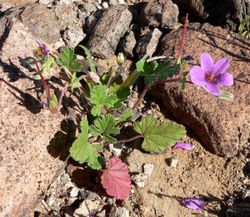| Erodium texanum | |
|---|---|
 | |
| Scientific classification | |
| Kingdom: | Plantae |
| Clade: | Tracheophytes |
| Clade: | Angiosperms |
| Clade: | Eudicots |
| Clade: | Rosids |
| Order: | Geraniales |
| Family: | Geraniaceae |
| Genus: | Erodium |
| Species: | E. texanum |
| Binomial name | |
| Erodium texanum | |
Erodium texanum, also known as Texas filaree, Texas stork's bill, or heronbill, is a flowering plant which is native to the southwestern United States and northern Mexico. It is an annual or biennial herb. [1]